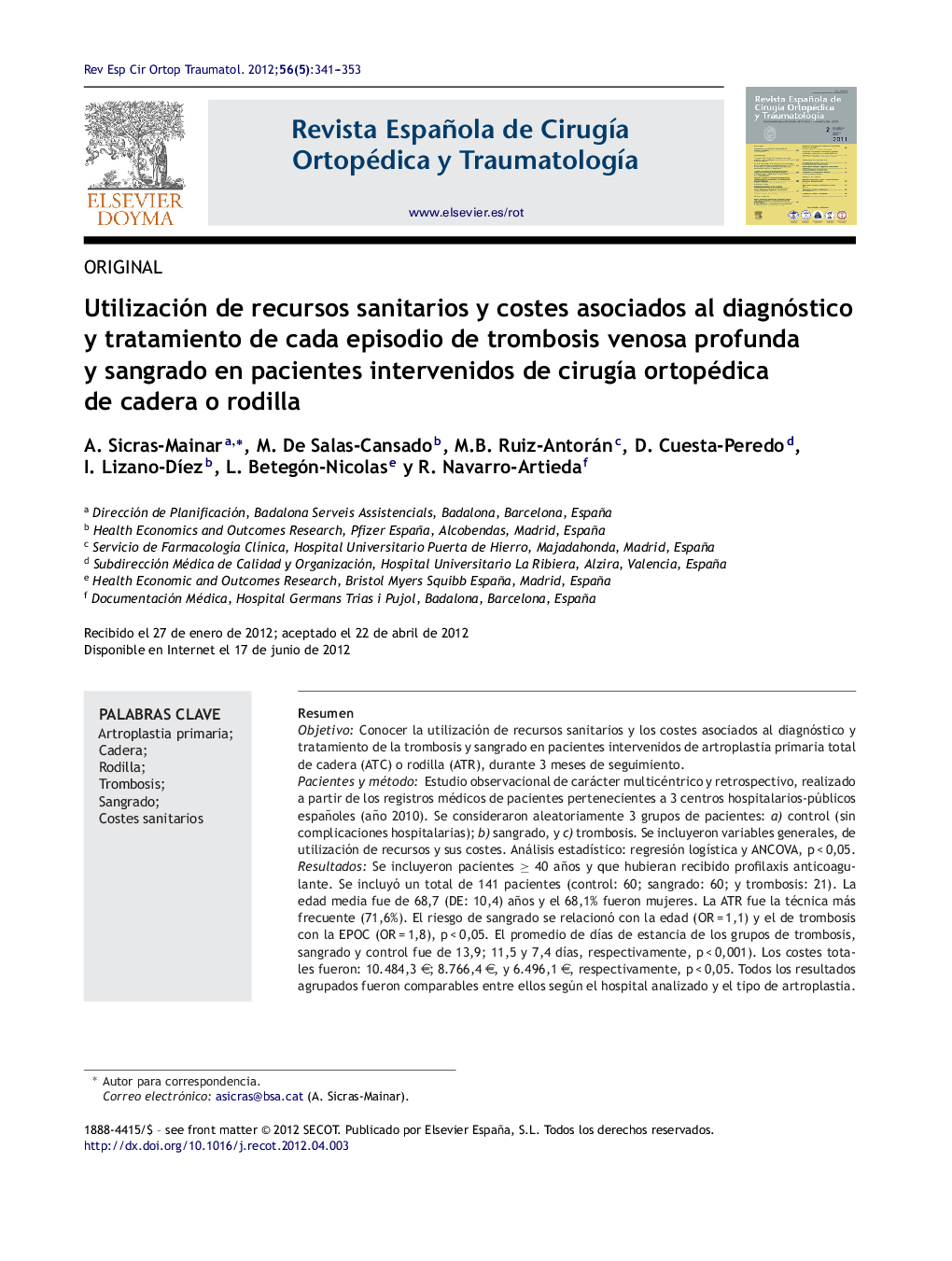| Article ID | Journal | Published Year | Pages | File Type |
|---|---|---|---|---|
| 4086279 | Revista Española de Cirugía Ortopédica y Traumatología | 2012 | 13 Pages |
ResumenObjetivoConocer la utilización de recursos sanitarios y los costes asociados al diagnóstico y tratamiento de la trombosis y sangrado en pacientes intervenidos de artroplastia primaria total de cadera (ATC) o rodilla (ATR), durante 3 meses de seguimiento.Pacientes y métodoEstudio observacional de carácter multicéntrico y retrospectivo, realizado a partir de los registros médicos de pacientes pertenecientes a 3 centros hospitalarios-públicos españoles (año 2010). Se consideraron aleatoriamente 3 grupos de pacientes: a) control (sin complicaciones hospitalarias); b) sangrado, y c) trombosis. Se incluyeron variables generales, de utilización de recursos y sus costes. Análisis estadístico: regresión logística y ANCOVA, p < 0,05.ResultadosSe incluyeron pacientes ≥ 40 años y que hubieran recibido profilaxis anticoagulante. Se incluyó un total de 141 pacientes (control: 60; sangrado: 60; y trombosis: 21). La edad media fue de 68,7 (DE: 10,4) años y el 68,1% fueron mujeres. La ATR fue la técnica más frecuente (71,6%). El riesgo de sangrado se relacionó con la edad (OR = 1,1) y el de trombosis con la EPOC (OR = 1,8), p < 0,05. El promedio de días de estancia de los grupos de trombosis, sangrado y control fue de 13,9; 11,5 y 7,4 días, respectivamente, p < 0,001). Los costes totales fueron: 10.484,3 €; 8.766,4 €, y 6.496,1 €, respectivamente, p < 0,05. Todos los resultados agrupados fueron comparables entre ellos según el hospital analizado y el tipo de artroplastia.ConclusionesLos costes más elevados se producen en los pacientes que habían desarrollado una trombosis y sangrado, respectivamente. Los costes se relacionaron con la prolongación de los días de estancia y las infecciones intrahospitalarias.
ObjectiveTo determine the use of healthcare resources and costs associated with the diagnosis and treatment of thrombosis and bleeding patients who have undergone elective hip or knee replacement surgery, in routine clinical practice conditions.Patients and methodsThis multicentre observational and retrospective study extracted data from the medical records of three Spanish public hospitals (2010). Patients ≥ 40 years who had received prophylaxis-anticoagulation were included. They were randomised into three groups: a) control (no hospital complications), b) bleeding, and c) thrombosis. General variables, use of resources and costs were analysed. Statistical analysis: logistic regression and ANCOVA for model correction, (P<.05) was included.ResultsA total of 141 patients (control: 60; bleeding: 60; and thrombosis: 21), with a mean age 68.7 (SD: 10.4) years, and 68.1% females were identified. Hip arthroplasty was more frequent (71.6%). The bleeding risk was associated with age (OR = 1.1) and thrombosis with COPD (OR = 1.8); P<.05). The average length of stay for the thrombosis, bleeding and control groups was 13.9, 11.5 and 7.4 days, respectively; P<.001). The total costs for each group were €10,484.3; €8,766.4 and €6,496.1 respectively; P<.05. All grouped results were comparable between them according to the hospital analysed and the type of replacement.ConclusionsCosts were higher for thrombosis and bleeding patients, respectively. Costs were associated with length of stay and hospital-acquired infections.
